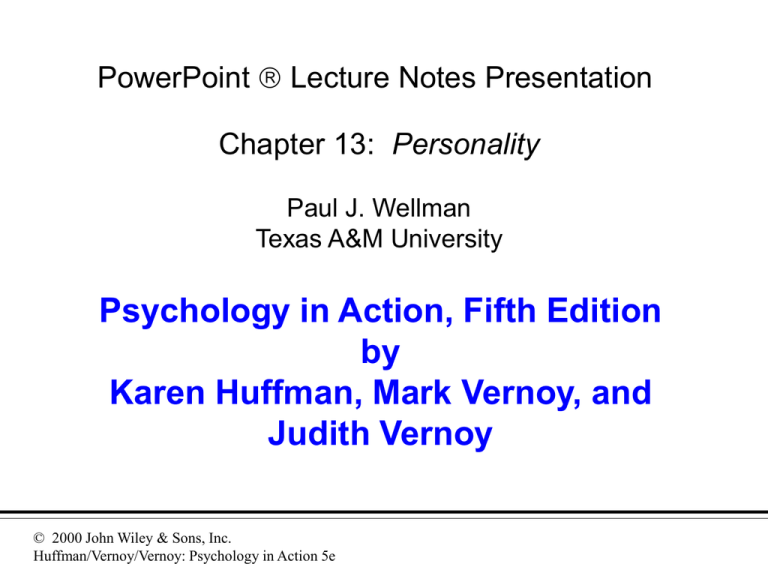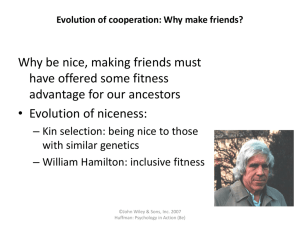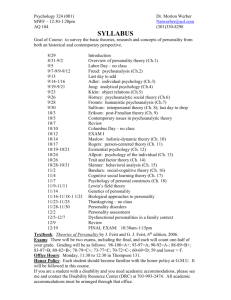
PowerPoint Lecture Notes Presentation
Chapter 13: Personality
Paul J. Wellman
Texas A&M University
Psychology in Action, Fifth Edition
by
Karen Huffman, Mark Vernoy, and
Judith Vernoy
© 2000 John Wiley & Sons, Inc.
Huffman/Vernoy/Vernoy: Psychology in Action 5e
Lecture Overview
•
•
•
•
•
•
Personality Assessment
Trait Theories of Personality
Psychoanalytic Theories of Personality
Humanistic Personality Theory
Social-Cognitive Approach to Personality
Biological Theories of Personality
© 2000 John Wiley & Sons, Inc.
Huffman/Vernoy/Vernoy: Psychology in Action 5e
Personality
• Personality refers to a person’s unique
and relatively stable pattern of thoughts,
feelings, and actions
• Personality is an interaction between
biology and environment
– Genetic studies suggest heritability of
personality
– Other studies suggest learned components
of personality
© 2000 John Wiley & Sons, Inc.
Huffman/Vernoy/Vernoy: Psychology in Action 5e
Measures of Personality
• Interviews
– Unstructured: “Tell me about yourself…”
– Structured: Set list of questions
• Observation: Psychologist learns about
personality by observing the person
• Objective tests: self-inventories
• Projective tests: subjects reveal their
personality during description of ambiguous
stimuli
© 2000 John Wiley & Sons, Inc.
Huffman/Vernoy/Vernoy: Psychology in Action 5e
Projective Tests
• Projection is the notion that people
reveal their true feelings and thoughts
when describing ambiguous stimuli
• Projective tests present ambiguous
stimuli and ask that subjects describe
the stimuli
– The idea is that their verbal descriptions will
reveal key aspects of their personality
© 2000 John Wiley & Sons, Inc.
Huffman/Vernoy/Vernoy: Psychology in Action 5e
Specific Projective Tests
• Rorschach test
– Consists of 10 inkblots
– Reliability and validity of this test is low
• Thematic Apperception Test (TAT)
– Consists of a series of ambiguous figures
– Was devised to measure achievement
motivation by Henry Murray in 1938
© 2000 John Wiley & Sons, Inc.
Huffman/Vernoy/Vernoy: Psychology in Action 5e
Personality Measurement Issues
• Objective self-report personality tests can be
criticized on the basis of
– Deliberate deception and social desirability bias
• Can the test detect deception and social desirability?
– Diagnostic difficulties: may not be sufficiently
specific to allow for diagnosis
– Inappropriate use: when tests are used for
purposes other than their designed use
• Use of a personality test to decide on a promotion
© 2000 John Wiley & Sons, Inc.
Huffman/Vernoy/Vernoy: Psychology in Action 5e
Personality Traits
• Traits are relatively stable and consistent
personal characteristics
• Trait personality theories suggest that a
person can be described on the basis of
some number of personality traits
– Allport identified some 4,500 traits
– Factor analysis techniques: 30-35 basic traits
– Eysenck argued there are 3 distinct traits
• Extraversion/introversion, neuroticism,
psychotocism
© 2000 John Wiley & Sons, Inc.
Huffman/Vernoy/Vernoy: Psychology in Action 5e
The “Big 5”
• Modern personality research argues for 5
basic personality traits (OCEAN)
• Openness: whether a person is open to new
experiences
• Conscientiousness: whether a person is disciplined
and responsible
• Extroversion: whether a person is sociable,
outgoing and affectionate
• Agreeableness: whether a person is cooperative,
trusting, and helpful
• Neuroticism: whether a person is unstable and
prone to insecurity
© 2000 John Wiley & Sons, Inc.
Huffman/Vernoy/Vernoy: Psychology in Action 5e
The Big “5”
© 2000 John Wiley & Sons, Inc.
Huffman/Vernoy/Vernoy: Psychology in Action 5e
Evaluating Trait Theory
• Trait theory, especially the Big 5 model is
able to describe personality
– Cross-cultural human studies find good
agreement for the Big 5 model
– Primate personality is accurately described by
the big 5
• Problems with trait theory include:
– Lack of explanation as to why traits develop
– Issue of explaining transient versus longlasting traits
© 2000 John Wiley & Sons, Inc.
Huffman/Vernoy/Vernoy: Psychology in Action 5e
Psychoanalytic Theory
• Psychoanalytic theory attempts to explain
personality on the basis of unconscious
mental forces
– Psychoanalytic theory was devised by Freud
• Levels of consciousness: Freud argued that much
of our mental states are unconscious
• Freud argued that personality is made up of
multiple structures, some of which are unconscious
• Freud argued that we have impulses that cause us
anxiety; our personality develops defense
mechanisms to protect against anxiety
© 2000 John Wiley & Sons, Inc.
Huffman/Vernoy/Vernoy: Psychology in Action 5e
Levels of Consciousness
© 2000 John Wiley & Sons, Inc.
Huffman/Vernoy/Vernoy: Psychology in Action 5e
Analytical Psychology
• Analytical psychology emphasized the
unconsciousness mind and its influence
on dream processes
– Devised by Carl Jung
– Two forms of unconscious mind
• Personal unconscious: unique for each person
• Collective unconscious: consists of primitive
images and ideas that are universal for humans
© 2000 John Wiley & Sons, Inc.
Huffman/Vernoy/Vernoy: Psychology in Action 5e
Criticisms of Psychonalytic
Theory
Difficult to test
Overemphasis on unconscious forces
Inadequate evidence
Sexism
Lack of cross-cultural support
© 2000 John Wiley & Sons, Inc.
Huffman/Vernoy/Vernoy: Psychology in Action 5e
Humanistic Theory
• Humanistic personality theories reject
psychoanalytic notions
– Humanistic theories view each person as
basically good and that people are striving
for self-fulfillment
– Humanistic theory argues that people carry
a perception of themselves and of the world
– The goal is to develop a positive selfconcept
© 2000 John Wiley & Sons, Inc.
Huffman/Vernoy/Vernoy: Psychology in Action 5e
Issues for Humanistic Theory
• Naïve assumptions
• Poor testability and inadequate evidence
• Narrowness
© 2000 John Wiley & Sons, Inc.
Huffman/Vernoy/Vernoy: Psychology in Action 5e
Interactionism
© 2000 John Wiley & Sons, Inc.
Huffman/Vernoy/Vernoy: Psychology in Action 5e
Copyright
Copyright 2000 by John Wiley and Sons, New York, NY.
All rights reserved. No part of the material protected by
this copyright may be reproduced or utilized in any form
or by any means, electronic or mechanical, including
photocopying, recording, or by any information storage
and retrieval system, without written permission of the
copyright owner.
© 2000 John Wiley & Sons, Inc.
Huffman/Vernoy/Vernoy: Psychology in Action 5e









